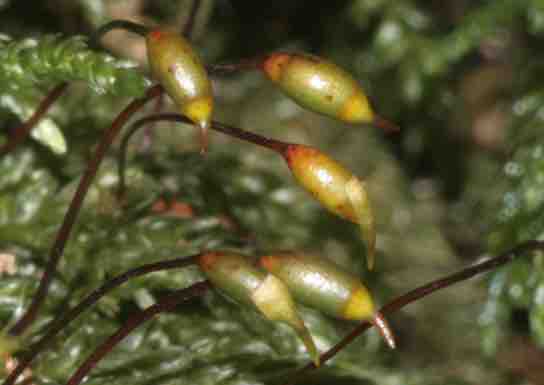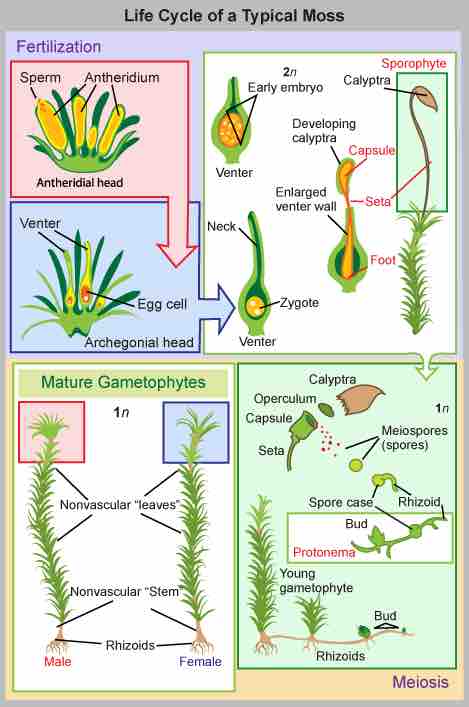Mosses
More than 10,000 species of mosses have been cataloged. Their habitats vary from the tundra, where they are the main vegetation, to the understory of tropical forests. In the tundra, the mosses' shallow rhizoids allow them to fasten to a substrate without penetrating the frozen soil. Mosses slow down erosion, store moisture and soil nutrients, and provide shelter for small animals as well as food for larger herbivores, such as the musk ox. Mosses are very sensitive to air pollution and are used to monitor air quality. They are also sensitive to copper salts. Such salts are a common ingredient of compounds marketed to eliminate mosses from lawns.
Mosses form diminutive gametophytes, which are the dominant phase of the life cycle. Green, flat structures resembling true leaves, but lacking vascular tissue are attached in a spiral to a central stalk or seta. The plants absorb water and nutrients directly through these leaf-like structures. The seta (plural, setae) contains tubular cells that transfer nutrients from the base of the sporophyte (the foot) to the sporangium . Some mosses have small branches. Some primitive traits of green algae, such as flagellated sperm, are still present in mosses that are dependent on water for reproduction. Other features of mosses are adaptations to dry land. For example, stomata are present on the stems of the sporophyte and a primitive vascular system runs up the sporophyte's stalk. Additionally, mosses are anchored to the substrate, whether it is soil, rock, or roof tiles, by multicellular rhizoids. These structures are precursors of roots. They originate from the base of the gametophyte, but are not the major route for the absorption of water and minerals. The lack of a true root system explains why it is so easy to rip moss mats from a tree trunk.

Setae
This photograph shows the long slender stems, called setae, connected to capsules of the moss Thamnobryum alopecurum.
The moss life cycle follows the pattern of alternation of generations . The most familiar structure is the haploid gametophyte, which germinates from a haploid spore and forms first a protonema: usually, a tangle of single-celled filaments that hug the ground. Cells akin to an apical meristem actively divide and give rise to a gametophore, consisting of a photosynthetic stem and foliage-like structures. Rhizoids form at the base of the gametophore. Gametangia of both sexes develop on separate gametophores. The male organ (the antheridium) produces many sperm, whereas the archegonium (the female organ) forms a single egg. At fertilization, the sperm swims down the neck to the venter and unites with the egg inside the archegonium. The zygote, protected by the archegonium, divides and grows into a sporophyte, still attached by its foot to the gametophyte.

Life cycle of mosses
The alternation of generations cycle begins when the gametophyte germinates from a haploid spore and forms a protonema. Apical meristem-like cells divide and give rise to the gametophores. The archegonium (female organ) and antheridium (male organ) develop on separate gametophores. After fertilization, the zygote divides and grows into a sporophyte, which stays attached to the gametophyte. Spores released from the sporophyte germinate and produce gametophytes; the process begins again.
A structure called a peristome increases the spread of spores after the tip of the capsule falls off at dispersal. The concentric tissue around the mouth of the capsule is made of triangular, close-fitting units, a little like "teeth"; these open and close depending on moisture levels, periodically releasing spores.